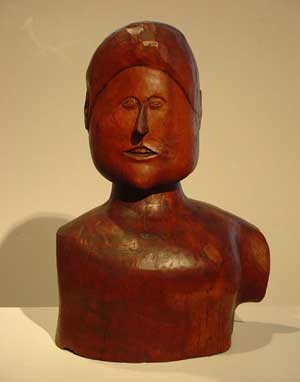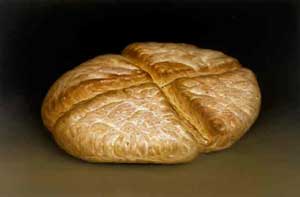
Gifted Nonconformity
Ten years at Lori Bookstein Fine Art; Derrick Guild at Allan Stone Gallery
By Maureen Mullarkey
COLLECTORS TRAVEL IN SCHOOLS, SAID ROBERT HUGHES, LIKE BLUEFISH. But connoisseurs — a very different species — make their singular way to Lori Bookstein Fine Art.
It has been ten years since Ms. Bookstein left Salander-O’Reilly to open a gallery under her own name. This anniversary exhibition illustrates why the gallery has become a resource for everyone who cares about the practice of painting, drawing and sculpture without regard to market trends.
Ms. Bookstein shares with the late Allan Stone a taste for gifted nonconformity. Ken Kewley, Irving Kriesberg, Henry Rothman (d. 1990), Varujan Boghosian and sculptor Louise Kruger are sui generis, true originals whose creative intuitions breathe life into art at a time when it is becoming just another mass product.
 |
| Louie Kruger, Bust of a Lady, c.1968 |
Ms. Kruger’s c.v. holds the cue to her unorthodox charm. “Apprenticed with Captain Sundquist, shipbuilder” substitutes for the usual academic affidavits. Her “Bust of a Lady” (c.1968) is a rough-hewn riff on a Renaissance noblewoman with delicately carved lips worthy of Clara Bow. [Watch for Ms. Kruger’s solo show in May.] Mr. Kriesberg’s “Flame” (1960) is a painting in four individual quadrants mounted on two steel dowels. Viewers can swivel any combination of double-sided quarters to achieve 16 distinct but harmonious variations on the original theme.
The shower of calibrated color shingles in Mr. Kewley’s collage “Bather Arranging Her Hair (After Renoir)", 2005, places him at the heart of the gallery’s founding interest: the coloristic legacy of Hans Hofmann. He is in good company with Louis Finkelstein’s 1992 pastel of color notes and Paul Resika’s recent, vivacious abstraction that skims the edge of representation.
John Dubrow ‘s “Union Square III” (2005-2006) reexamines the structure of a previous treatment of a favorite urban motif. He uses color, as fine painters do, to amplify the texture of things and suggest the sculptural reality of simplified forms no less than the quality of light. The rigor of his color chords marks him as one of the most discerning contemporary painters.
The juxtapositions on view are striking and fertile. Willard Boepple’s horizontal sculpture sets near Janet Malcolm’s collage, echoing its darksome, disappearing angles. A paint-encrusted Crucifixion by Gandie Brody (d. 1975) hangs next to Bruce Gagnier’s current variation on the theme: a slim, twisted cry of anguish. It is an inspired Lenten pairing. David Park’s 1953 profile portrait of his wife converses with Mr. Dubrow’s Bay Area inclinations and Robert De Niro, Sr.’s early — and delicious — ”Still Life with Greek Head” (1951). A female head (c. 1929), elongated and a bit dotty, by Albert Maurer seems to recognize itself in Ms. Kruger’s sculpted bust.
Only Eve Ascheim’s near-monochrome white painting seems out of sync with the visual generosity characteristic of the gallery. Its aggressive minimalism begrudges the viewer anything to look at. But then, the gallery has included surprises since it opened.
There is not enough column space for everything worth noting in this medley of contemporary work and earlier modern ones. Names have to suffice: Jan Müller, Marsden Hartley, Rosemarie Beck, Leland Bell, Louisa Matthíasdóttir (including an uncommon plaster female bust), Tine Lundsfryd, Susanna Phillips, Wendy Mark, Anne Tabachnick, Garth Evans, Aristodimos Kaldis, Walker Buckner, Jolie Stahl and Jonathan Silver.




SCOTTISH ARTIST DERRICK GUILD IS A SLOW, DELIBERATE PAINTER who meditates on foodstuffs, one cauliflower or custard slice at a time, as if they were beads on a rosary. This is his third solo exhibition at the Allan Stone Gallery, and his first in New York in seven years.
 |
| Derrick Guild, Bread |
His scrupulous verisimilitude has been a component of the still life tradition since it began. Still life grew in stature in tandem with emphasis on the laws of optics until “imitation of nature” became the catchphrase of Renaissance treatises on art. Mr. Guild imitates the natural world — and its baked goods — with sly humor, lending a surreal quality to a plucked chicken, a sprouting sweet potato, a ham shank, strawberry tart, or stuffed goldfinch. The fudge glaze on a cream doughnut could bring sparrows down to peck.
Each individual object is silhouetted against a blackened void that isolates forms and absorbs contours. Handling owes much to 16th and 17th century Spanish painting. Luis Meléndez, Juan de Zurbarán and Juan Sánchez Cotán come straight to mind in these spare compositions. And the ghosts of Goya’s dead birds, his plucked turkey and “Still Life with Pieces of Rib Loin and a Head of Mutton” haunt the mix.
The show’s title, “Pre-Ascension,” has a double meaning. On one level, it refers to the hint of perishability residing in these quirky, somewhat plaintive still lifes. Vegetables rot; eclairs crumble and go stale. Mortality, a prerequisite for ascension, is implicit in the motifs and in the genre’s name, nature morte. But there is a literal meaning as well. When this show ends, the artist is off to a two-year stay with the fauna and fare of Ascension Island in the South Atlantic.
For Mr. Guild’s admirers, a Dundee bakeshop is no less exotic.




“Anniversary: Ten Years of Gallery Art and Artists” at Lori Bookstein Fine Art (37 West 57 Street, 212-760-0949).
“Derrick Guild: Pre-Ascension” at Allan Stone Gallery (113 East 90th Street, 212-987-4997).
This review first appeared in The New York Sun, April 5, 2007.
Copyright 2007, Maureen Mullarkey







